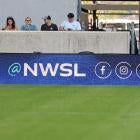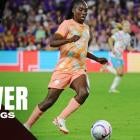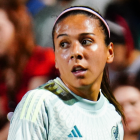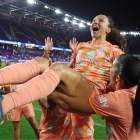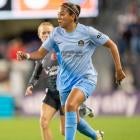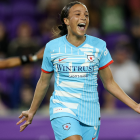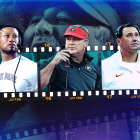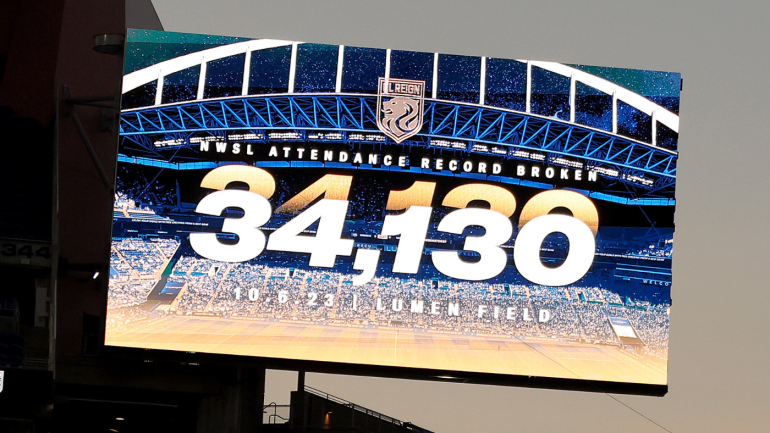
In some ways, the NWSL's biggest storyline is itself. The league has spent the last couple of years publicly documenting its exponential rise in several categories, including its brand-new media rights deal, one which is reportedly the most valuable in women's soccer. Chief among them over the course of the 2023 season, though, is the attendance figures.
The NWSL's median attendance grew 40% from last year after more than 1.2 million fans packed stadiums during the regular season, commissioner Jessica Berman said in a Friday press conference. Average attendance is up 26% league-wide, and new single game attendance mark was also notched when more than 34,000 filled Lumen Field for Megan Rapinoe's final regular season home game with the OL Reign. The NWSL will likely cap off a strong year for attendances with a sizable crowd for Saturday's championship at Snapdragon Stadium, which has quickly emerged as an incredibly hospitable venue for women's soccer. Fans can stream the match live on CBS or with the Paramount+ premium plan.
What is most impressive, though, is that most of the league's teams could brag about moments of their own this season. Nine teams drew more than 10,000 fans on at least one occasion and the league doubled the number of games that hit that attendance record this season. Eight of the NWSL's 12 teams set or equaled individual attendance records in 2023, while 10 teams saw their average crowd size increase from last year's numbers.
The near-universal success comes amidst a wide range of strategies that allowed both expansion teams and older sides to excel, providing a positive outlook on the league's health in the process.
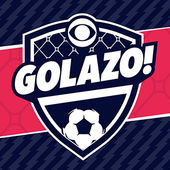
Golazo Starting XI Newsletter
Get your Soccer Fix from Around the Globe
Your ultimate guide to the Beautiful Game as our experts take you beyond the pitch and around the globe with news that matters.
Thanks for signing up!
Keep an eye on your inbox.
Sorry!
There was an error processing your subscription.
Bigger and better venues
Perhaps the most obvious explanation for the NWSL's attendance growth in recent years is the fact that teams are now playing in bigger -- and better -- venues. Five of the league's teams upgraded their stadium situations in the last three seasons, including the Washington Spirit, NJ/NY Gotham FC and the OL Reign, all of whom were original NWSL franchises.
The Spirit only began to call Audi Field, the 20,000-seater opened by MLS' D.C. United five years ago, their full-time home this year. The team historically split their time between the Maryland SoccerPlex and Segra Field, both of which were in the Washington, D.C. suburbs and only sat 5,000. The move to Audi Field was an obvious improvement but came with its challenges.
"We have a history of playing all over the place so it's confusing for fans, so it took a little bit of time to educate," Spirit COO Theresa McDonnell told CBS Sports. "We did a smaller media campaign in January and February just letting people know that … I think people feel, at least more locally near Audi, more affiliation to the Washington Spirit and more fandom to the Washington Spirit because we're here."
McDonnell said the move to Audi Field also allowed the Spirit to target new demographics and expand their fanbase. The team ran promotions directed at families with promotions that involved kids eating free night or $5 tickets for college students. A more targeted group the Spirit prioritized was young professionals, and geared a brunch-themed game towards them.
"We know that they like to go out to eat together and for example, they like to go to brunch together, so we had an early game on a Saturday at 1 [p.m.] and we did a bottomless brunch promotion," she said. "Basically, what they would probably have spent anyway going to brunch, they also got to have a really good time and be in a really good environment and watch an amazing soccer match."
Want more coverage of women's soccer? Listen below and make sure to watch Attacking Third on Golazo Network Monday, Wednesday and Friday for all your USWNT, NWSL and WSL women's soccer coverage.
Upgrading stadiums also provided benefits to expansion teams like the Kansas City Current and the San Diego Wave, who began their NWSL journeys at smaller venues before successfully moving into bigger arenas. The Current broke their attendance record twice this season at Children's Mercy Park, home of MLS' Sporting Kansas City that seats 18,000, which allowed the city to demonstrate its credentials as an untapped women's soccer market. The club will test the theory further beginning next season, when it opens the 11,000-seater CPKC Stadium, the first stadium built specifically for women's soccer.
"Having more space gives us an opportunity to grow our fans and grow our fanbase exponentially," current vice president of marketing Jocelyn Monroe told CBS Sports. "Nothing against Legends [Field, which seats 10,000] but as we grow, we need a larger space to just spread our wings ... [and] a space where we can build out a soccer-specific experience for our fans, because we want them to feel our game."
The stadium change and marketing efforts played a large factor in the Current and Spirit's year-over-year attendance growth -- the Current said their average crowd size grew 51% from last year, while the Spirit's jumped 87%.
Growth without a World Cup bump
The NWSL's attendance triumph is even more impressive considering what didn't happen. The league missed one thing that it enjoyed in previous years -- the Women's World Cup bump. The league saw fans flock to games after the U.S. women's national team's win in 2015 and even more so in 2019, but their round of 16 exit this year meant the tournament did not deliver the same impact.
"Being honest, I don't think that the World Cup had the impact that it did in 2019," McDonnell said. "We sold out the match after they won the World Cup in 2019 and we're really proud of the numbers we had in August, September, October, but they weren't close to that number."
That does not mean that the World Cup bump was nonexistent. McDonnell said the tournament successfully lifted the profile of Spirit star Trinity Rodman, which did drive up attendance at Audi Field.
"I think it put players like Trinity [Rodman] and [Sophia Smith] on more of a global stage, and then we played the [Portland] Thorns, our first match coming back [had] over 13,000 people at it," she added. "I think people got to see them and wanted to see them play each other then and it was sort of the perfect first match for us to have coming out of that."
The World Cup also provided other opportunities for NWSL clubs to grow their platforms. McDonnell said the Spirit used the event as a hook to increase brand awareness regionally and ran the club's largest ever ad campaign, including spots on TV, out of home advertising, as well as digital and radio messaging. The Current, meanwhile, notably used the opportunity to advertise their soon-to-open stadium and grow their brand recognition outside of their immediate market.
History was made at the #FIFAWWC. We’ll keep it going.
— KC Current (@thekccurrent) August 21, 2023
📍 Sydney pic.twitter.com/u3vbdmG62v
"One of the things we're really trying to highlight as this stadium comes to life is that people can come be a part of history," Monroe said. "We are quickly selling out, which is an amazing thing, but you can be a part of history by connecting to us digitally, socially. ... We have the right opportunity to create fans not just that live in our communities and can fortunately go and be in attendance of our games, but to be fans of our games across the world."
Investment influx
The attendance growth also coincides with increased investment in the NWSL, chiefly through new owners. Since the 2019 World Cup, four teams have seen massive ownership changes, while the league added four additional expansion teams. The upcoming sales of the Reign and the Portland Thorns will only add to that number, while just about every team has seen a bunch of minority investors join their ranks. It has allowed NWSL teams to level up in just about every category, changing the complexion of the league along the way.
There have been distinct advantages for expansion teams, who launched with impressive funding and the ability to hit the ground running.
"Coming in as an expansion team, we were able to see what has been laid in growing the foundation of this league," Monroe said. "We're not only just a young team, we're a young league when you look across the landscape and really using the knowledge of what worked for other teams, where have there been challenges that we can get ahead of."
While newcomers like the Current, the Wave and Angel City are the face of the NWSL's new era, they are not the only ones ensuring the league has a new-and-improved look. The injection of cash for older clubs like the Spirit to catch up to their younger counterparts, and a shared desire to grow means all the clubs have a sense of camaraderie.
"When Michele [Kang] took over the Spirit, we became a startup and it's one thing to work in a startup environment and another thing to work in a 10-year old startup environment," McDonnell said. "Last season, Michele kept texting me every single thing Angel City was doing, all wonderful things. ... I think the advantage of the expansion clubs coming in is that we can learn from them, too, and we all have great relationships with each other and everyone's really transparent and we recognize that if we all do well, women's sports will do well and we all win."
It's hard not to acknowledge the timing of the increased investment. The league was forced to usher in a new era after a reckoning on systemic abuse began in 2021, which revealed many of its shortcomings. Some owners who enabled abuse, like the former Spirit owner Steve Baldwin, also underfunded the team, and were eventually replaced by investors who wanted to ensure a safe and professional environment in every aspect.
For a club like the Spirit, there's a straight line between improving workplace safety and ensuring players -- and fans -- experience the game in the most ideal circumstances.
"Part of Michele's vision is to build the most pre-eminent sports organization in the world and with that comes creating a premier sports environment," McDonnell said. "[Audi Field] is just so much more professional for the players. It's where they deserve to be playing. ... Everything needs to be at that highest level and they deserve that, so it was a huge difference maker for us."
'Rocket fuel' for growth
Berman described the attendance boost as "the rocket fuel that drives all of the growth," of which there is much to speak of. In addition to crowd size and the new media agreement, the commissioner said viewership grew this season and that all of the teams enjoyed sponsorship growth in 2023. She believes that the NWSL offers a lot of unique selling points for fans, investors, and businesses alike that has them all rushing to engage.
One of the first things Berman pointed to was the fact that the NWSL operates independently of a men's league, allowing the league to invest "for the right reasons" and have "a level of authenticity" in its story.
Above all, though, it's the fact that the NWSL can sell itself as a top product. Its copetitiveness is a selling point, but the league seems to be finding ways to capitalize on the fame of its players without the specific need of a World Cup bump. Berman said she looks to the NBA as an example of a league with an image built on star power, and aims to mirror that thanks to the cultural relevance of the players.
"They are people who are not just relevant on the pitch because they are athletes but because they stand for so much more than that and that cultural relevance makes them superstars," Berman said. "We lift up the stars that are in our league and we believe that has driven a lot of the success."













